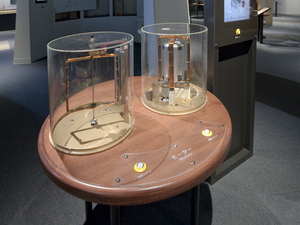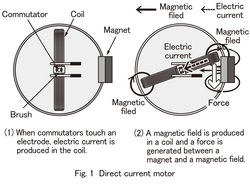Nagoya City Science Museum
TOP > Exhibition Guide > Keyword Search > Starting with "D" > direct current motor > Motors
Motors

Purpose of Exhibition
There are different kinds of electric motors, and you will come to understand the mechanism in which the two most typical motors, direct current motors and induction motors, rotate.


Additional Knowledge
Motors are referred to as "moving" and "rotating". Other than motors rotating with electricity, there are a variety of motors like engines moving with gasoline, ultrasonic motors and participle motors, etc.
We call rockets with fixed fuels rotating". When it comes to motorcycles, they are auto-bicycles.
We will explain to you the motors rotating with electricity. They are called electric motors as well.
The motors move by means of the functions of electricity and magnetic fields. There are some different ways motors function in how electric current generates, coils are allotted, magnetic fields are transferred and so on. There are different kinds of models in embodied motors.
In the exhibit, we show not only "direct current motors" in which electromagnetic formulation for school learning holds true, but also "induction motors" in which you will learn how motors rotate without magnets.
[Direct current motors]
Direct current motors are quite plainly structured. With electric-wire curled coils themselves rotating, coils are supposed to receive force only when passing through nearby magnets. The force received when coils pass through nearby magnets is allotted towards the direction of the rotating coils, and motors can be created because of the triangular relationship between generating force, the direction of electric current, and the direction of lines of magnet force, each of which crosses at the right angle (A formulation of Fleming left hand). Things other than these are devised by using a so-called commutator for generating electric current into coils if necessary.
[Induction motors]
We do not understand induction motors as easily as direct current motors. Seen from high above, the two coils are allotted to be crossing. The parts in a motor called the rotors are surrounded by coils. When you switch the motor on, electric current generates in coils and rotors rotate. We cannot see what makes rotors rotate because electric current and magnets are invisible to the human eyes.
The way to electrify is a little complicated in two coils. Firstly, put electricity in only one coil. Secondly, stop the electric current and put electricity in the second coil. Then, stop the electric current and the put a reversed electric current in the first coil. Stop the electric current again and put the reversed electricity in the second coil. Then stop the electric current and return to the previous state, and put the firstly-directed same electricity in the first coil. This action is continuously carried out. In the exhibit, this cycle is repeated 60 times per second. When you repeat this, the magnetic fields rotating in coils are generated. When putting the electricity in the first coil, the magnetic force also generates toward penetrating the coils. The magnetic force generated in the second coils is at a right angle to the magnetic force, which is generated in the first coil, because two coils are allotted at the right angle.
If the orientation is reversed towards electric current, it is also opposed towards force of magnetic lines. As mentioned above, if you put the electricity in the coils in turn, the direction toward the force of magnetic lines in coils tend to be coiling. By means of force of rotating magnetic lines, rotors in the middle rotate. We call this motor an induction motor because it generates electric current inducted by magnets in rotors.
Article by Yoshitaka Yamada, curator
